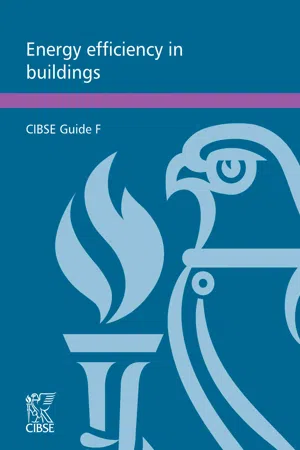
- English
- PDF
- Available on iOS & Android
Guide F: Energy efficiency in buildings
About this book
Since the last edition of CIBSE Guide F, published in 2004, the UK Government has set a legally binding target to reduce national greenhouse gas emissions. The Government's latest Carbon Plan sets out specific targets for improving the energy efficiency in new and existing buildings. There have also been significant regulatory changes over the last eight years, including two revisions to Part L of the Building Regulations and the transposition of the Energy Performance of Buildings Directive into UK legislation. The next two revisions of Part L will push for further improvements in energy efficiency to progress towards the Government's aspiration for all new buildings to be zero carbon by 2019.This 2012 edition of CIBSE Guide F includes a new section on 'developing an energy strategy'. This reflects the changes to planning policy which now include targets for reducing carbon dioxide emissions from new developments and the need to submit a detailed energy strategy report as part of the planning application.Energy management has moved up the corporate agenda, aided by the work of the Carbon Trust and the implementation of the CRC Energy Efficiency Scheme. Part B of this Guide (covering the operation of the building) has been updated to include more information about carbon management, and the need for improved metering and monitoring.The section on energy efficient refurbishment has been expanded in recognition of the pressing need to upgrade the existing building stock and the opportunities to improve performance.This edition incorporates the new and revised guidance that has been published since 2004. This includes key CIBSE documents and publications by the Carbon Trust and BSRIA. These key references have informed many of the updates and are referenced throughout the Guide.The new companion guide, Introduction to energy efficiency, introduces the main Guide and summarises the current policy agenda, the changing role of building services engineers, and the key themes of Guide F.
Frequently asked questions
- Essential is ideal for learners and professionals who enjoy exploring a wide range of subjects. Access the Essential Library with 800,000+ trusted titles and best-sellers across business, personal growth, and the humanities. Includes unlimited reading time and Standard Read Aloud voice.
- Complete: Perfect for advanced learners and researchers needing full, unrestricted access. Unlock 1.4M+ books across hundreds of subjects, including academic and specialized titles. The Complete Plan also includes advanced features like Premium Read Aloud and Research Assistant.
Please note we cannot support devices running on iOS 13 and Android 7 or earlier. Learn more about using the app.
Information
Table of contents
- CIBSE Guide F: Energy efficiency in buildings OFC
- Foreword
- Contents
- Principles of energy efficiency
- 1 Introduction
- Part A: Designing the building
- 2 The design process
- 3 Developing a design strategy
- 4 Developing an energy strategy
- 5 Concept design
- 6 Control strategies
- 7 Ventilation and air conditioning design
- 8 Refrigeration design
- 9 Lighting design
- 10 Heating and hot water design
- 11 Motors and building transportation systems
- 12 Electrical power systems and office equipment
- 13 Checking the design
- 14 Commissioning, handover and feedback
- Part B: Operating and upgrading the building
- 15 Managing the building
- 16 Acquisition and refurbishment
- 17 Maintenance and energy efficiency
- 18 Energy audits and surveys
- 19 Benchmarking, monitoring and targeting (M&T)
- Part C: Benchmarks
- 20 Energy benchmarks
- Appendix A1: Conversion factors, fuel data and correction of meter readings
- Appendix A2: Consultants and model briefs
- Index